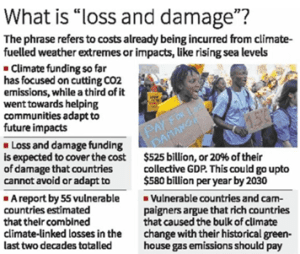TAG: GS 3: DISASTER AND DISASTER MANAGEMENT
THE CONTEXT:
Recent landslides in Kerala’s Wayanad district have highlighted the urgent need for effective climate finance.
EXPLANATION:
About the Loss and Damage Fund (LDF):
● The formal agreement at the 19th Conference of the Parties (COP 19) to the United Nations Framework Convention on Climate Change (UNFCCC) in Warsaw, Poland, in 2013, led to the establishment of the Loss and Damage Fund.
● It aims to provide financial support for regions suffering both economic and non-economic losses caused by climate change, including extreme weather events and slow-onset processes like rising sea levels.
● Oversight and Management:
Governing Board: Oversees the LDF and determines the disbursement of resources.
Interim Trustee: The World Bank serves as the interim trustee.
Disbursement Mechanisms: The Board is developing mechanisms for accessing funds, including direct access, small grants, and rapid disbursement options.
● Challenges: Climate funds, including the LDF, are often criticized for being slow to become accessible immediately after a disaster, which can be particularly problematic for local communities at the sub-national level.

India’s Role and Challenges
- Damage from Disasters: India has experienced over $56 billion in damages from weather-related disasters between 2019 and 2023.
- Focus on Mitigation: India’s National Climate Action Policy and budgets have prioritised mitigation over adaptation, resulting in less engagement in Loss and Damage dialogues.
- Need for Framework: There is an urgent need for a clear legal and policy framework in India to manage climate finance, especially for adaptation and loss and damage, and to support locally led adaptation efforts.
- Expectations: The introduction of a climate finance taxonomy in the Union Budget 2024 raises hopes for increased international climate finance but lacks clear guidelines for accessing loss and damage funds.
Need for State-Level Support:
- States like Kerala, which face acute climate impacts, bear substantial disaster recovery costs.
- The Rebuild Kerala Development Programme is an example of state-led recovery funded through international loans, highlighting the need for dedicated climate finance.
Challenges in Accessing the Fund:
- Bureaucratic Delays: Climate funds, including the Loss and Damage Fund (LDF), are often slow to disburse, particularly after disasters, affecting immediate relief efforts.
- Lack of Standardised Assessments: Absence of a comprehensive method for evaluating disaster-related damages, especially from slow-onset events, can hinder effective fund allocation.
- Centralised Systems: Current mechanisms for climate finance are largely centralised, potentially limiting the effectiveness of fund distribution at the local level.
Approve of a particular action:
- Develop Local Frameworks: India needs clear legal and policy frameworks to streamline climate finance, focusing on locally led adaptation and clearer guidelines for accessing loss and damage funds.
- Advocate for Decentralization: In international forums, India should push for more decentralised disbursement methods to ensure funds reach affected communities more efficiently.
- Improve Assessment Processes: Establish standardised processes for assessing and quantifying disaster-related damages to better qualify for and utilise LDF resources.
SOURCE:
Spread the Word

